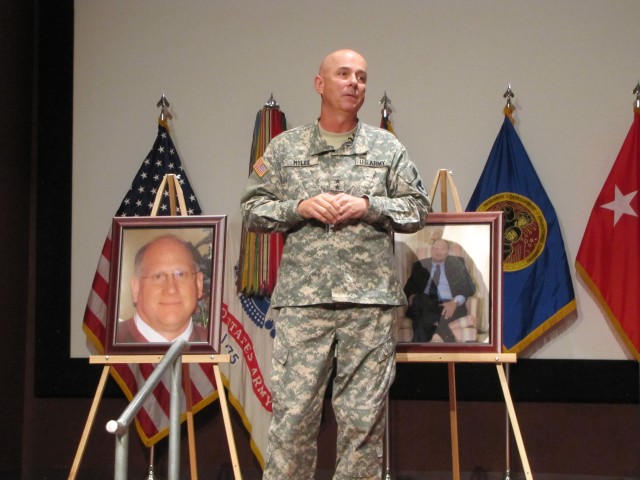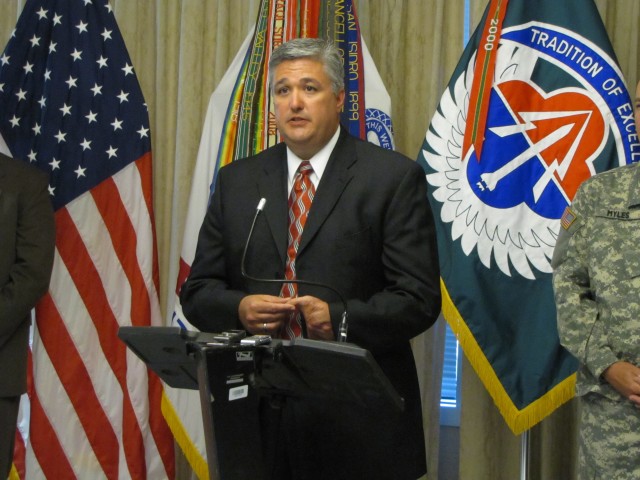REDSTONE ARSENAL, Ala. -- Two Redstone Arsenal events - one a May 10 press conference, the other a May 13 memorial service - were part of the grieving process in the acceptance of the deaths of two Team Redstone employees involved in high-risk research and development.
The press conference publicly addressed questions related to the investigation of a May 5 explosion at building 7354 at Test Area 10 that killed Aviation and Missile Research Development and Engineering Center contractors Jerry Grimes and James Hawke; while the memorial service was a private event to help Team Redstone employees say goodbye to two citizen Soldiers.
And, at both events, Maj. Gen. Jim Myles, commander of the Aviation and Missile Command and Redstone Arsenal, vowed that a thorough investigation would uncover the cause of the explosion, and that no additional research and development associated with the accident would resume until its cause is determined and steps are taken to prevent such an accident from happening again.
"It's so important to get to the bottom of this so it doesn't happen again ... This is an incredibly sad time for all of us. We've lost two great Americans, two valued members of this Team Redstone," Myles said at the press conference.
The general said there are four priorities associated with the May 5 explosion - assist the families of the victims as they go through the grieving process, assist the employees of AMCOM and Team Redstone as they share in that grieving process, determine the cause of the explosion and continue Team Redstone's critical mission to support the Soldier.
Grimes and Hawke were working to refine a process to extract a pure form of ammonium perchlorate from solid rocket propellant to be recycled in other missile systems. Currently, aged and obsolete missiles containing ammonium perchlorate are destroyed either through detonation or burning, which both have detrimental effects on the environment.
"Just about every air defense system, just about every missile system - Javelin, TOW, MLRS, PAC (Patriot Advanced Capability) 2, PAC 3 -- uses ammonium perchlorate," Myles said. "These missiles help to keep us free. They all use AP, and they are created and managed out of Redstone Arsenal."
The Army began using ammonium perchlorate about 50 years ago, said Paul Turner, AMRDEC's associate director for Propulsion and Structures Directorate, referring to it as the "workhorse" in many tactical missile systems.
"As these missiles become older, it is our responsibility to determine: Are these missiles still able to be used' We've been demilitarizing those items for many years with an open burn, open detonation that is not favorable to the environmental community," Turner said.
Hawke and Grimes were finalizing the stages of the ammonium perchlorate process at about 8:45 a.m. May 5 when the explosion occurred, Turner said. They had already run through the process, had retrieved quality ammonium perchlorate from the process and were making necessary adjustments in the process when the explosion occurred.
"In the past, the ammonium perchlorate still had particulates of other items from the propellant. We were not able to reuse it. We were refining the AP one more time to remove those impurities out," Turner said. "We had run several runs of this (particular) process and had gotten quality AP out. We were making necessary adjustments before making the transition (to using the process in demilitarization activities)."
If ammonium perchlorate is to be recycled, it needs to be in a pure form.
"They were trying to get the ammonium perchlorate as pure as they possibly could," Myles added. "As it becomes pure it has more value for warheads and agricultural purposes. Other processes (in the past) were really not a clean process at all ... They were repeating a process that had occurred before. We need to find out why this time the explosion occurred."
Myles said that recycling ammonium perchlorate is one of many "critical research and development" activities at Redstone that carry risk.
"We deal with things that are pretty inherently dangerous," he said. "We make them as safe as we possibly can. We try to mitigate risk."
Officials involved in the accident investigation will take all the time needed to thoroughly go through every element of the process the two employees were working on. There was a video monitor in the estimated 20,000-square-foot building and Arsenal investigators hope to use video recordings to help in their investigation.
"We owe it to the family, we owe it to the work force and we owe it to our country and the taxpayer (to find the cause of the accident)," Myles said. "We ask for patience because it will take time. But at the end of the day, we'll know, you'll know, what happened."
The Bureau of Alcohol, Tobacco and Firearms, the FBI and the Occupational Safety and Health Administration have conducted an investigation.
The Arsenal team now working on the investigation includes a senior research scientist (ballistics research) from the Army's Research Laboratory, Aberdeen Proving Ground, Md., an expert form the Army's Technical Center for Explosive Safety, a medical adviser from Fox Army Health Center, a safety inspector from Army Materiel Command, a propulsion safety expert from the Aviation and Missile Command, retired propulsion and chemical processing experts (one of whom pioneered and developed the process used in the May 5 accident), technical advisers from the Huntsville Corps of Engineers and retired Explosive Ordnance Disposal officers.
It is the work of Team Redstone's 34,000 employees that make Soldiers confident in the missile systems they use in defense of freedom.
"I continue to be amazed about this work force and what gets accomplished," Myles said.
Hawke and Grimes were two of those employees, both dedicated to their work and to their families, and both leaders in their communities.




Social Sharing